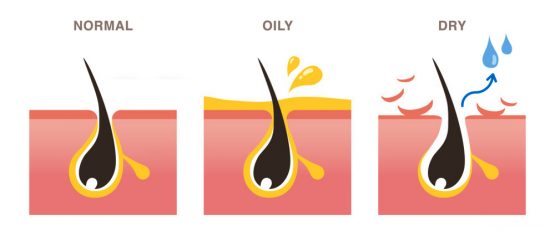- You have no items in your shopping cart
- Continue Shopping
Each skin is unique. It is therefore important to be familiar with all skin types and diseases. How do I know which skin type I have?
Different types of skin
To classify different skin types, there are several criteria. Fitzpatrick’s classification was first described in 1975. It is based on skin colour and how it reacts to sunlight exposure. It can be used, among other things, to determine the best type of sun protection factor and to predict the risk for skin cancer. From a cosmetic standpoint, skin can be classified according to three factors: its balance, sebaceous secretion and hydration, as well as its sensitivity level. Each skin type will be unique and will require different care. Although genetics determine the type of skin, it can also be affected by other factors.
These characteristics are the basis of five types healthy skin: dry, normal, oily, oily, combination (both dry and oily skin), and sensitive. Below are the main characteristics for each type.
These hair tests will reveal that your hair is likely to be a mixture of two types: curly and very porous or fine and dry. It doesn’t matter what your hair type is, it will help you make better hair care decisions and ensure that your hair looks and feels great.
NORMAL SKIN
It is neither too oily nor too dry. It is smooth and has no flaws.
SENSITIVE SKIN
Sensitive skin reacts more strongly to stimuli than normal skin. Sensitive skin is fragile and can cause discomfort such as itching, heat, tightness, or redness. This skin type loses its protective barrier function. It is more open to microorganisms and other irritants, increasing the risk of infection and allergic reactions. This type of skin is delicate and requires more care to combat dryness, roughness, and maintain its normal appearance. It is sometimes called sensitive skin, but they are both the same and there are no dermatological distinctions between them.
DRY SKIN
Dry skin can be caused by many external factors, such as weather, low humidity, or immersion in hot water. It is often temporary. Dry skin can be more frequent and may even become a permanent condition in some people. Dry skin can cause cracks, which makes it more susceptible to bacteria. However, this condition is generally not dangerous.
The signs and symptoms of dry skin can vary depending on age, health status, or cause. The most common symptoms are tightness and roughness. You may notice a grayish color and itching. Cracked skin can be seen in dry skin. It usually has small cracks that may become deeper or even bleed in more severe cases.
Atopic skin is a form of skin disease that causes dry, itchy skin. Although genetic predisposition is the main reason, other factors can trigger or aggravate it. These may include environmental, allergic, food, and/or clothing.
OILY SKIN
Oily skin is porous and shiny. This is usually caused by excess fat production by the sebaceous glands. It can also be caused by hormonal and genetic factors. It is common in teenagers and young adults under 30 years of age and often associated with acne.
COMBINATION SKIN
Its location can indicate both oily and dry skin. This is because the distribution of sweat and sebum glands isn’t uniform. The T-zone (forehead and nose) is the most oily. While the skin on the cheeks can be normal or dry, it is the area with the most oil.
SCALY SKIN
Skin desquamation is a result of repeated skin irritation caused by environmental factors such as the sun and wind, dryness, excessive humidity or dryness. This refers to the separation of large scales from the epidermis. Sometimes these can look like fine dust. Desquamation can also occur due to an allergy, fungal, staphylococcus, cancer, or other conditions. Desquamation can be accompanied by itching in these situations.
RED SPOTS
Red spots and rash can be caused by many dermatological conditions, including heat, allergies, medications, and immune system disorders.
SKIN MOLES
Moles are dark spots or dots on the skin that appear in childhood and adolescence. These spots are usually caused by a group of pigmented cells. They are generally harmless but you should consult a dermatologist if the color, size or shape changes or if there is itching or bleeding. Some may even become cancerous.

It is important to be aware of your skin’s appearance.


